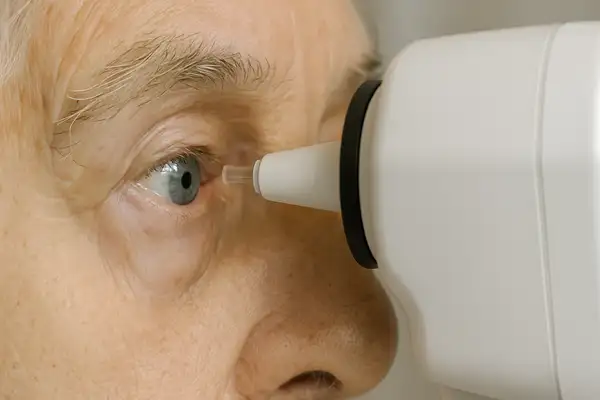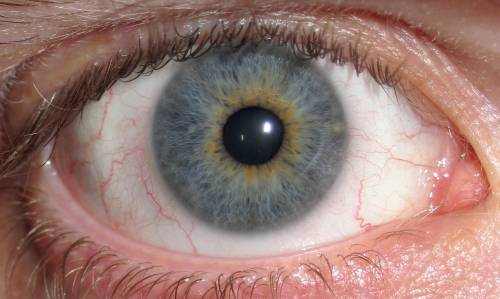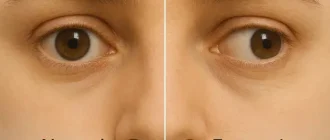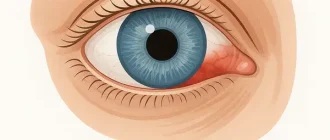When it comes to eye health, few numbers matter as much as normal intraocular pressure. It’s like the “blood pressure” of your eyes — too high or too low, and things can get messy fast. This delicate balance keeps your vision clear, your optic nerve healthy, and your chances of developing glaucoma at bay.
Intraocular — or eye — pressure isn’t something most people think about until their optometrist raises an eyebrow. But when this normal… pressure starts to drift out of range, your eyes may quietly signal that something’s not right. And let’s be honest, no one likes silent trouble when it comes to eyesight.
Both low and high intraocular pressure can play tricks on your vision. Low can blur things; high can damage the optic nerve. The goal? Keep it steady, balanced, and checked regularly — because your eyes deserve the same attention you give your smartphone screen every day.
What Is IOP
Intraocular pressure (IOP) is the fluid pressure inside your eyeball — yes, your eyes are not hollow but filled with a clear liquid called the aqueous humor. Think of it like a car tire: it needs the right amount of air to roll smoothly. Too little, and the tire collapses; too much, and it bursts. Similarly, your eyes need just the right amount of internal pressure to maintain their shape and function properly.

The normal range for IOP is 10–21 mmHg (1.3–2.8 kPa). When it stays within that window, vision tends to remain sharp and stable. But if the pressure rises above 21 mmHg, it could strain the optic nerve and gradually lead to glaucoma. On the flip side, low pressure (below 8 mmHg) can cause blurred vision and eye discomfort.
Most people never feel their IOP changing, which is why regular eye exams are so important. In fact, according to the American Academy of Ophthalmology ⧉, nearly half of those with early glaucoma have no idea they’re affected until significant vision loss occurs.
IOP Range
The ideal IOP can slightly vary by age, genetics, and health conditions. Below is a general chart showing how it tends to fluctuate across age groups:
| Age Group | Average IOP (mmHg) | Common Factors |
|---|---|---|
| 20–39 yrs | 14–16 | Hormonal balance, minimal eye stress |
| 40–59 yrs | 15–17 | Early lens changes, screen time increase |
| 60+ yrs | 16–18 | Slower fluid drainage, risk of glaucoma |
Patients with diabetes, high myopia, or a family history of glaucoma often exhibit slightly higher IOP readings. As Reyus Mammadli, medical consultant, notes: “Maintaining normal IOP is not just about numbers; it’s about protecting the optic nerve before symptoms appear.”
Measuring IOP
Measuring eye pressure might sound intimidating, but it’s actually quick, painless, and surprisingly simple. Let’s walk through the main methods and what patients can expect during each.
Goldmann Applanation Tonometry
This is considered the gold standard for measuring intraocular pressure. During this test, the doctor uses a special microscope called a slit lamp. After placing numbing drops in your eyes, a tiny prism lightly touches the cornea — you won’t feel pain, only a soft pressure or tickle. A blue light is used to measure how much force it takes to flatten a small part of your cornea. The result appears instantly on the device’s screen.
Accuracy: 9/10
Average cost: $50–80 (45–70 €).
It’s fast, precise, and the entire process takes less than two minutes. According to studies ⧉, this method remains the most trusted in clinical settings.
Non-Contact Tonometry (Air Puff Test)
If the idea of something touching your eye makes you uncomfortable — good news! This test doesn’t involve contact. You’ll rest your chin on a support, and the device releases a short puff of air toward your cornea. It measures how the cornea changes shape in response to the puff. No pain, just a quick blink reflex.
Accuracy: 7/10
Average cost: $30–60 (25–55 €).
The results are immediate and usually printed or saved electronically for your record. It’s the go-to method for quick screenings.
iCare Tonometer
The iCare tonometer is a handheld device often used for home monitoring or by clinics during children’s exams. It gently taps the cornea with a small disposable probe — most patients barely notice it. There’s no need for anesthetic drops, and readings appear instantly.
Accuracy: 8/10
Average cost: device $2,000 (for clinics), single use $5–10.
It’s perfect for patients who require frequent tracking of their eye pressure, such as those with diagnosed glaucoma.
Dynamic Contour Tonometry
This advanced digital method measures how your eye’s surface naturally curves rather than flattening it. It provides more personalized and accurate readings, especially for people with thin or irregular corneas. The doctor positions a small sensor against your eye (after numbing drops) for a few seconds, and a digital readout shows the IOP value.
Accuracy: 9/10
Average cost: $60–100 (55–90 €).
According to modern ophthalmic research ⧉, it delivers superior precision for complex corneal structures.
All methods are safe and completed in just a few minutes. The results help your ophthalmologist track eye pressure trends and detect glaucoma risk early — often before any vision loss occurs.
Causes
So, what makes eye pressure spike or drop? Several everyday and medical factors can influence it. Understanding these helps you recognize potential risks hidden in plain sight.
Fluid Imbalance
When the eye produces more aqueous humor than it drains, pressure inside the eyeball rises. This can happen due to age-related changes in the drainage angle or inflammation blocking fluid pathways. Imagine a sink with a partially clogged drain — the water level rises because outflow can’t keep up with inflow.
Medications (Steroids and Others)
Corticosteroids are a well-known cause of increased IOP. Common examples include Prednisone, Prednisolone acetate (Pred Forte) eye drops, Dexamethasone, Fluticasone inhalers (used for asthma), and Triamcinolone injections for allergies or joint pain. Long-term use of these medications — even in nasal sprays or skin creams — can elevate eye pressure in susceptible individuals ⧉. If you’re on any of these, regular ophthalmic monitoring is strongly advised.
Eye Injury
Blunt trauma, such as being hit by a ball or involved in a car accident, can disrupt the delicate drainage system of the eye. Sometimes the pressure rises immediately; other times, it increases years later. Think of it as tiny structural scars that slowly affect the fluid flow.
Post-Surgery Effects
Eye surgeries, especially cataract or retinal procedures, can temporarily change how fluid circulates inside the eye. After cataract surgery, some people experience mild pressure fluctuations for several weeks until healing stabilizes.
Real-Life Cases
To make it relatable, here are two real stories from U.S. clinics:
Case 1: The Retiree from Florida
Richard, 67, an avid fisherman from Tampa, noticed halos around streetlights at night. He assumed it was fatigue. During a routine check, his IOP measured 27 mmHg — higher than normal. After starting on Timolol drops and adjusting his steroid nasal spray, his readings normalized to 16 mmHg within two months. His doctor joked that he “caught the problem before it caught him.”
Case 2: The Graphic Designer from California
Emily, 45, from San Diego, underwent retinal surgery. Weeks later, she developed low pressure, leading to temporary visual distortion like “looking through water.” Her doctor prescribed anti-inflammatory drops and scheduled weekly follow-ups. Within a month, her pressure balanced, and her vision returned to normal. She described it as “an eye-opening reminder to never skip post-op visits.”
These examples show that IOP fluctuations are manageable when detected early and treated promptly ⧉.
Treatment
Treating abnormal intraocular pressure depends on its cause, severity, and how the eye responds. Below are the main approaches, each explained clearly so you’ll know what to expect.
Eye Drops
These are usually the first line of defense. Eye drops help reduce fluid production or improve drainage.
- Common medications: Latanoprost (Xalatan), Timolol (Timoptic), and Brimonidine (Alphagan).
- How it works: Latanoprost opens new drainage pathways (like unclogging a pipe), while Timolol slows fluid production.
- Dosage: Typically one drop in each affected eye once or twice daily, often at night for prostaglandin drops.
- Comfort: Mild burning or redness may occur but fades quickly.
- Effectiveness: 7–9/10 for most early to moderate cases.
- Average cost: $30–80 per bottle (25–75 €) depending on brand and insurance.
Laser Therapy (SLT)
Selective Laser Trabeculoplasty (SLT) uses a low-energy laser to gently open the drainage meshwork in the eye.
- How it works: The laser targets pigment cells in the drainage system, stimulating better outflow without damaging tissue.
- Procedure length: About 10–15 minutes per eye, done in an outpatient clinic.
- Comfort: You’ll feel a mild flash of light but no pain; numbing drops are used.
- Recovery: Vision may be slightly blurry for a few hours, then normalizes.
- Effectiveness: 8–9/10, results can last 3–5 years.
- Average cost: $1,000–2,000 (900–1,800 €) per session ⧉.
Micro-Stent Surgery
Tiny implants, such as iStent or Hydrus Microstent, are used to keep fluid pathways open.
- How it works: Think of these stents as “mini straws” that help fluid leave the eye more easily.
- Procedure: Usually performed alongside cataract surgery under local anesthesia; takes about 30 minutes.
- Comfort: Minimal discomfort; most patients return to daily activities in 24–48 hours.
- Effectiveness: 9/10 for sustained IOP reduction in moderate glaucoma.
- Average cost: $2,000–3,000 (1,800–2,700 €) including surgery.
Combination Therapy
Some patients need more than one approach — for example, drops plus laser, or drops plus stent.
- How it works: Combining methods helps control pressure when a single treatment isn’t enough.
- Comfort: Adjusting schedules or drops may take time, but most adapt easily.
- Effectiveness: 9/10 when properly customized.
- Average cost: Varies from $150 (medications) to $3,000 (multi-step treatments).
Each of these options has proven safe and effective when monitored by an ophthalmologist. As Reyus Mammadli notes, “Treatment is no longer one-size-fits-all — it’s tailored like a suit, precise and built to protect your vision for decades.”
Healthy Habits
Small, consistent lifestyle choices can go a long way in maintaining stable eye pressure. Below are clear, structured habits — with real examples — to make them practical.
Stay Hydrated the Right Way
Water is essential for maintaining healthy eye fluid balance. But chugging a whole bottle at once can cause brief pressure spikes. Instead, sip half a cup (about 120 ml) every 30–40 minutes throughout the day. The general goal: 1.5–2 liters (50–70 oz) daily.
Best choices include plain water, herbal teas, or infused water with cucumber or lemon. Avoid soda, energy drinks, and too much coffee — caffeine and sugar can dehydrate and momentarily raise IOP ⧉.
Eat for Eye Health
Your plate can be your eye’s best friend. Choose foods that help fluid circulation and protect the optic nerve:
- Leafy greens (spinach, kale, romaine) — rich in lutein and zeaxanthin.
- Fatty fish (salmon, sardines) — full of omega-3s that support drainage.
- Citrus fruits — vitamin C boosts blood vessel elasticity.
Try a “glaucoma-friendly” meal: grilled salmon, quinoa, and steamed spinach with olive oil.
Tip: Limit salty processed foods — salt retains fluid, which may elevate IOP.
Practice Gentle Eye Exercises
While no exercise directly lowers IOP, relaxing eye muscles helps reduce tension from long screen hours. Try this every day:
- Look 20 feet away for 20 seconds every 20 minutes.
- Roll your eyes slowly clockwise and counterclockwise (five times each).
- Close your eyes and gently press your palms over them for 10 seconds — it soothes optic strain.
You can even pair these mini breaks with deep breathing for full-body relaxation.
Sleep and Posture Matter
Sleep deprivation and head-down positions (like reading on the couch with your chin tucked) can raise IOP. Aim for 7–8 hours of sleep nightly and avoid napping face-down.
For extra comfort, elevate your pillow slightly to improve fluid drainage from the eyes overnight.
Manage Stress and Screen Time
Chronic stress raises cortisol, which can influence eye pressure. Find simple relaxation tactics — short walks, chatting with friends, or mindful breathing.
If you spend hours at a computer, use anti-glare lenses and take a “digital detox” for five minutes every hour. As Reyus Mammadli notes, “Even short breaks can protect your eyes from long-term strain.”
See a Doctor
Eye pressure should be checked at least once every 1–2 years after age 40, or earlier if you have a family history of eye disease. Warning signs include blurred vision, headaches, or rainbow rings around lights. According to the CDC ⧉, early testing saves over 50% of vision-related complications linked to undiagnosed glaucoma.
Editorial Advice
Reyus Mammadli, medical consultant, recommends regular IOP monitoring even in the absence of symptoms: “Most eye diseases progress quietly. Prevention through awareness and routine checks is your best protection.”
If you’re over 40, schedule an annual exam. Discuss your baseline IOP with your doctor and keep track of any changes. Remember, your vision doesn’t have a reset button — so treat it with care, curiosity, and a pinch of humor. After all, seeing clearly is one thing you don’t want to take lightly.





